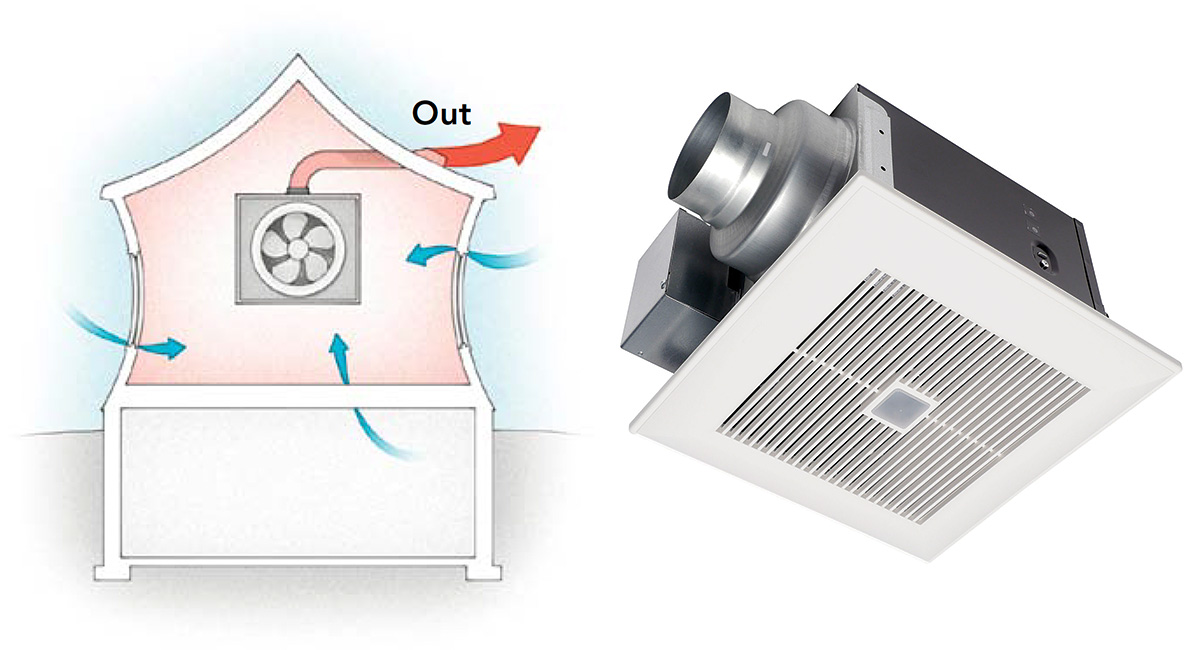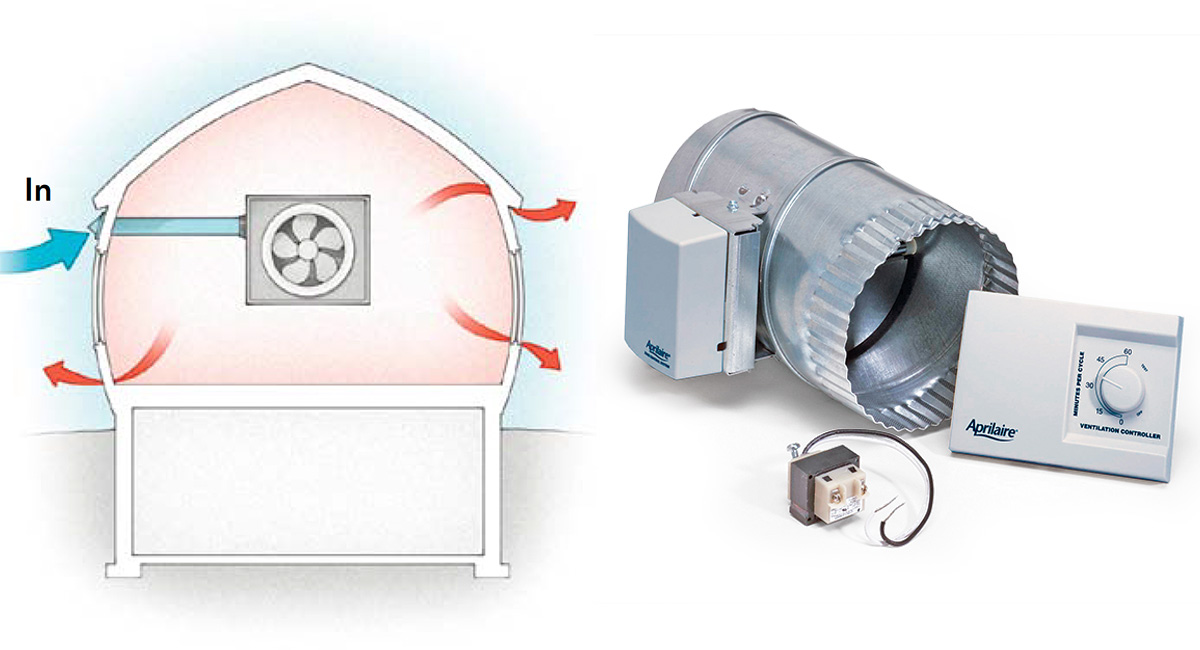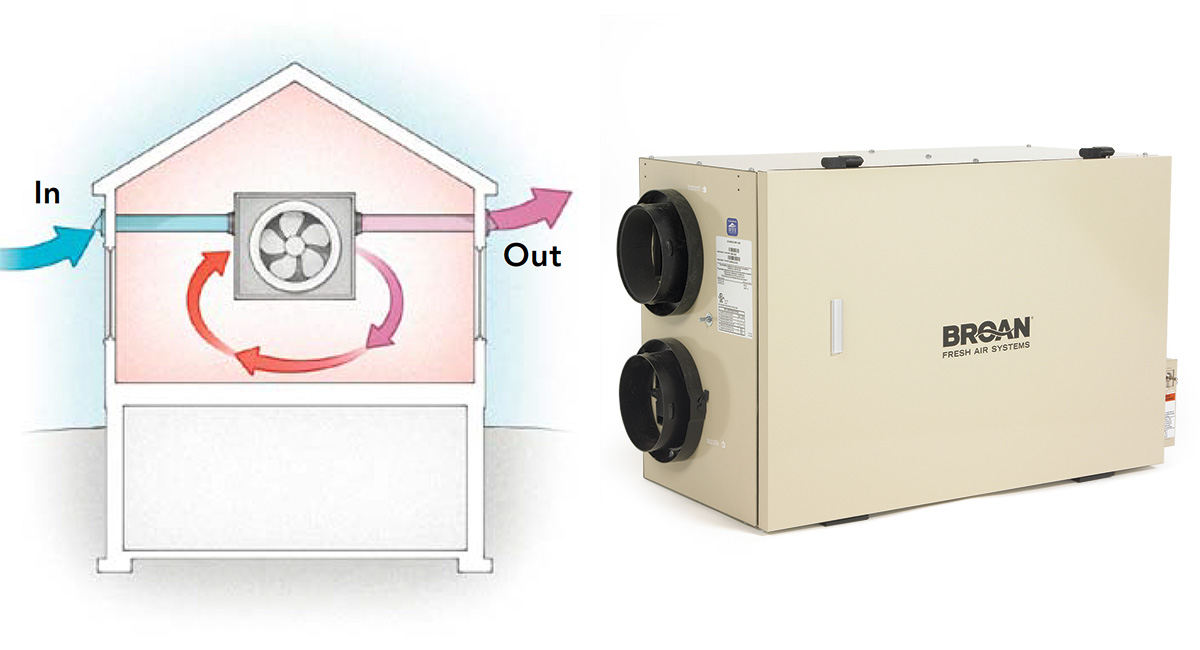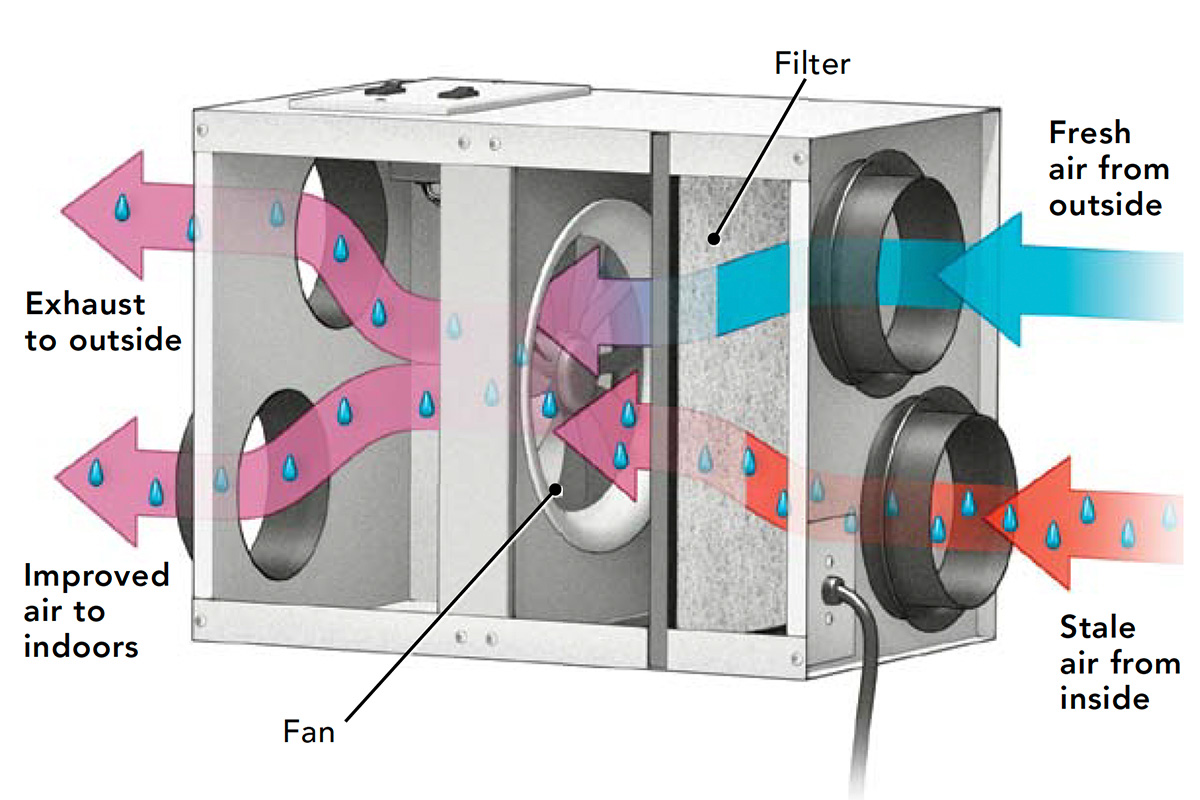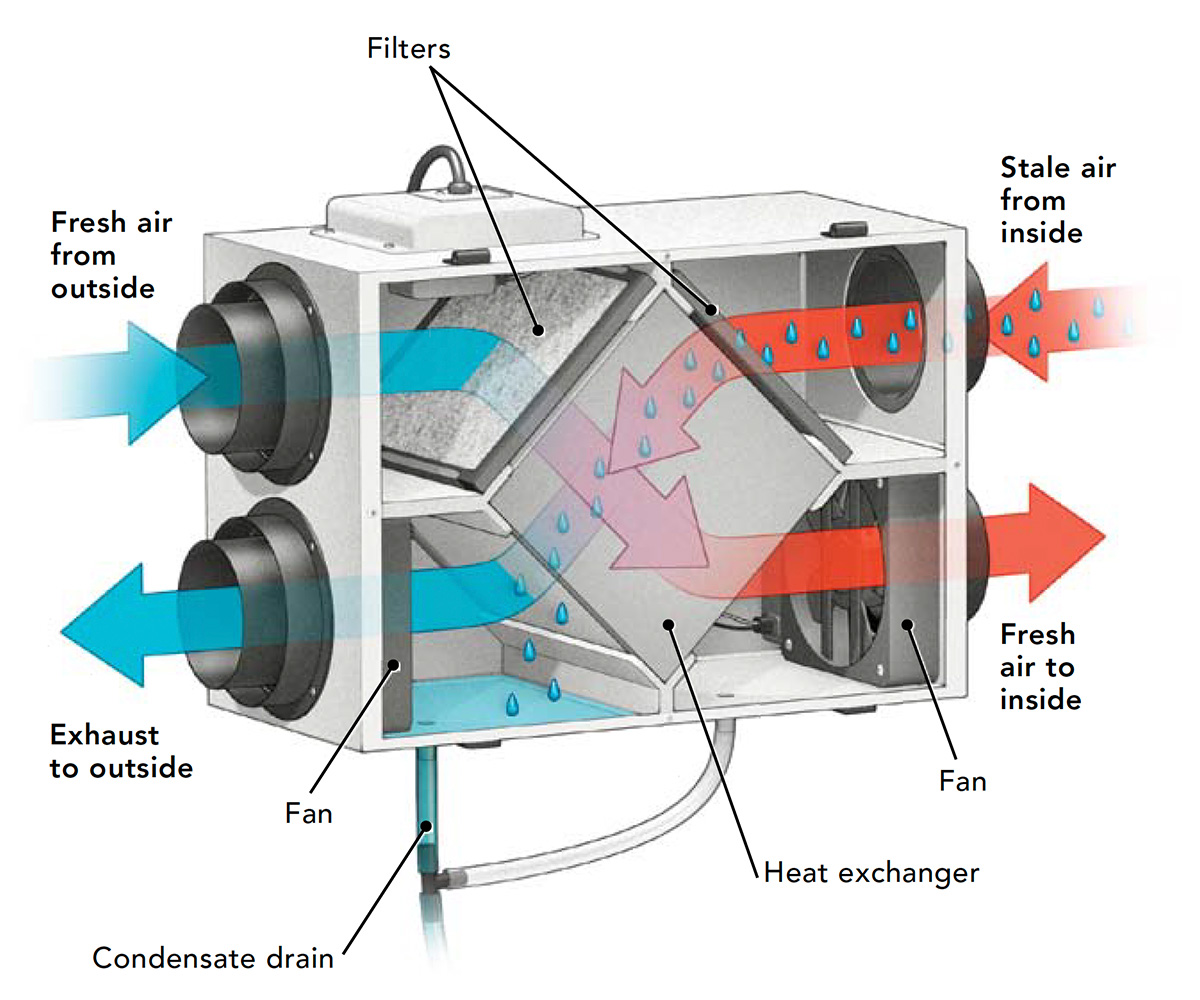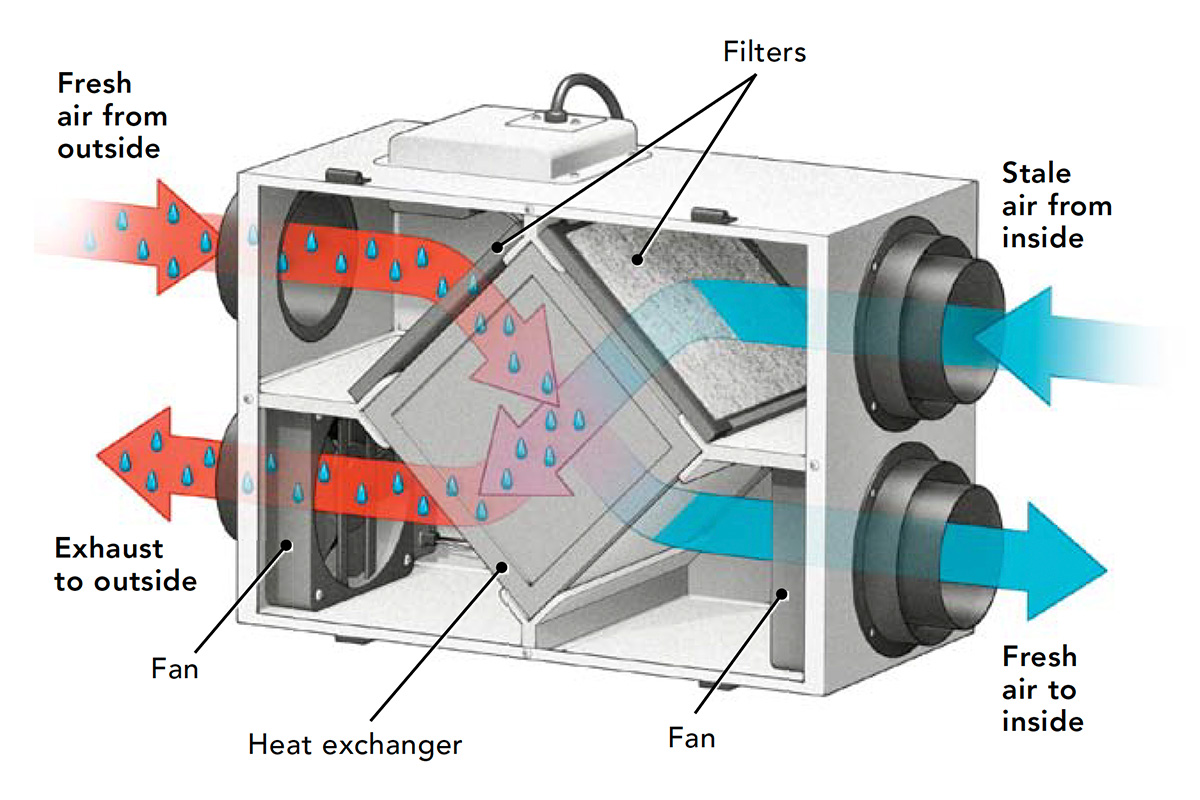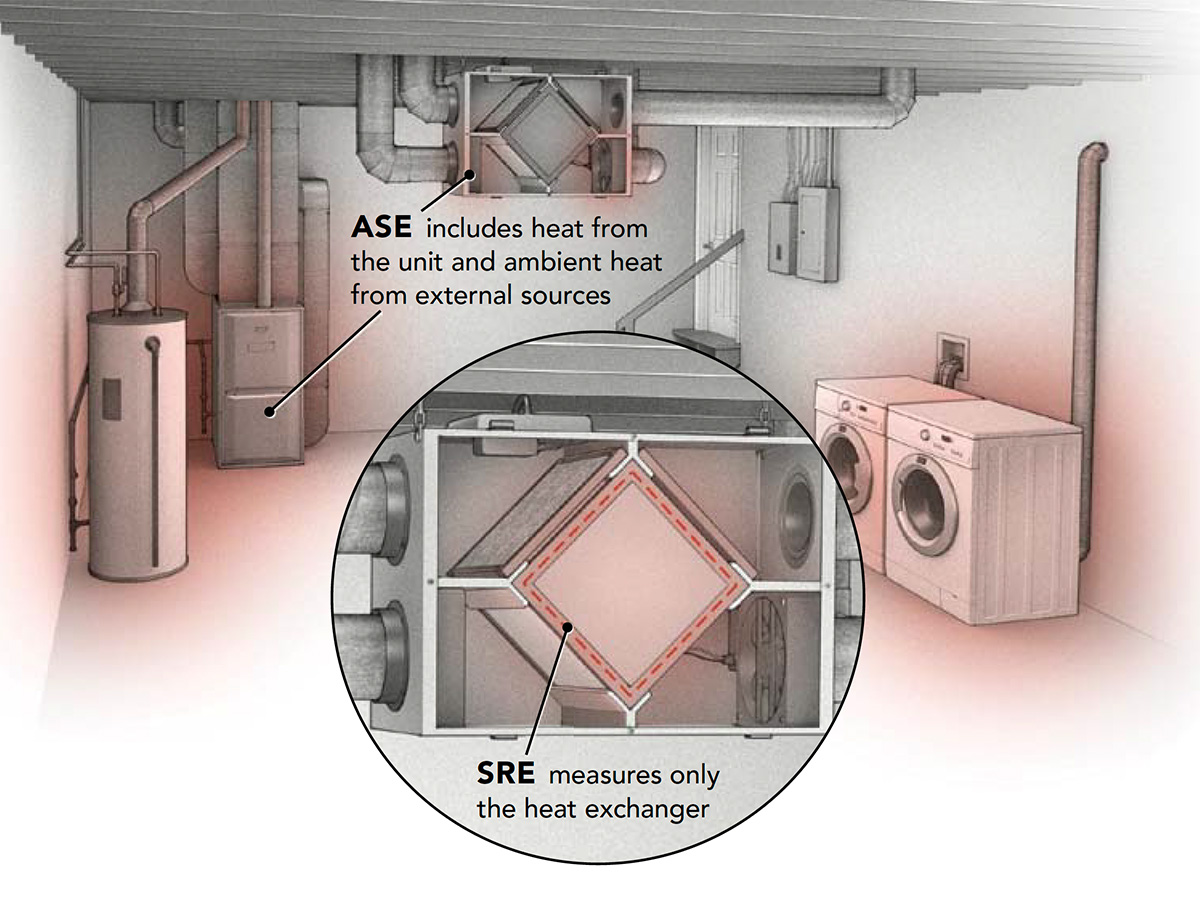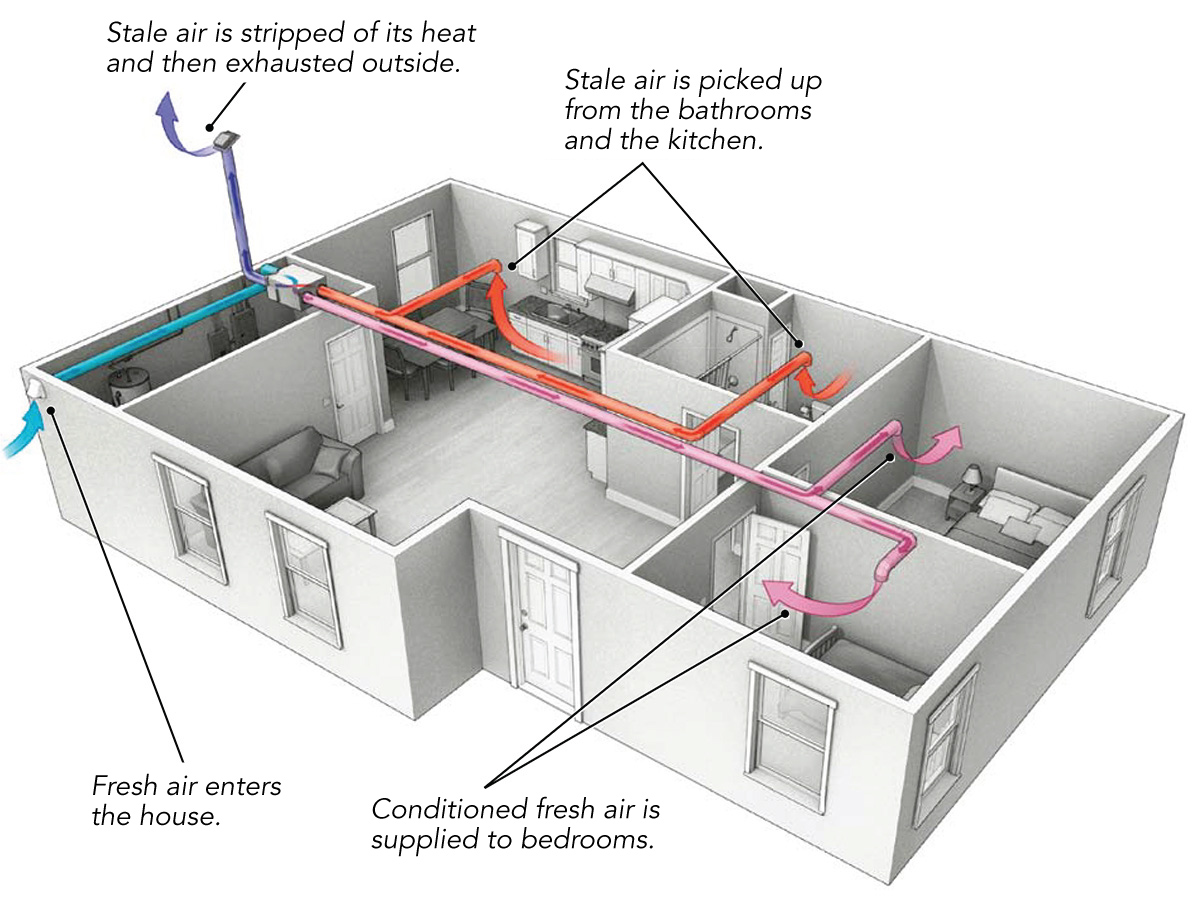Breathe Easy with Balanced Ventilation
The best ventilation solutions provide fresh air to the whole house without a severe energy penalty.
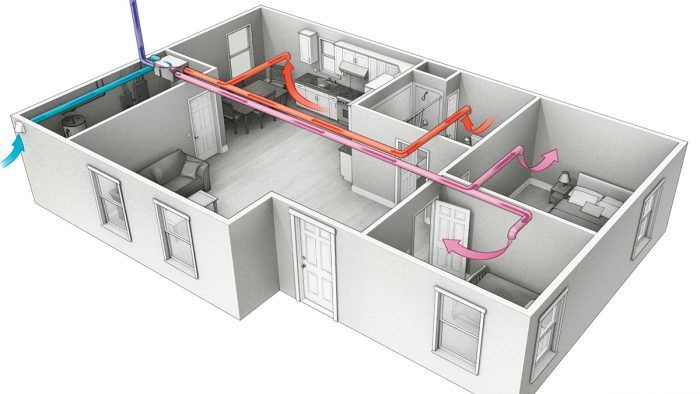
Synopsis: All houses need to exhaust stale air and bring in fresh air. Many do this through various leaks in the building envelope. As houses have gotten tighter in the last few decades, however, leaks have become an insufficient means of ventilation. In this article, contributing editor Sean Groom discusses three ways of ventilating a house. The worst way is to use exhaust-only ventilation provided by a bath fan. A better way is to use supply-only ventilation through a fan that pulls fresh air into the house. The best way is to use a balanced ventilation system such as that provided by an air exchanger, an HRV (heat-recovery ventilator), or an ERV (enthalpy-recovery ventilator). Groom explains how each of these systems works, aided by detailed illustrations. He also provides guidance for choosing between an HRV and an ERV. Sizing a balanced ventilation system is key for ensuring maximum performance and efficiency, and Groom includes tips on doing the necessary calculations. He concludes by explaining why it’s important to separate your heating and air conditioning from your ventilation system.
Houses need fresh air. Without ventilation, the quality of indoor air can rapidly become worse than that of the outside air; that holds true even in urban areas. Common contaminants include gases, odors, and moisture, and these can stem from utility rooms, garages, basements, bathrooms, and kitchens.
Until recently, fresh air entered a typical house through various openings, whether intentional (a fan or open window) or unintentional (holes and leaks around windows, rim joists, door jambs, and sheathing penetrations). Over the last few decades, however, houses have become tighter, and the unintentional flow of air through the building envelope has been reduced. Once a house reaches about five air changes per hour (ACH), it’s important to start thinking about using mechanical ventilation to ensure indoor-air quality.
In regions with moderate to significant heating and/or cooling loads, HRVs and ERVs are the most efficient means of mechanical ventilation. Depending on the efficiency of the heat exchanger, it can transfer anywhere from 50% to 91% of the conditioned air’s heat and energy to the supply air.
Homeowner satisfaction with a recovery ventilator will depend on the answers to three questions: Does it keep the air temperature comfortable? Is it cheap to operate? Is it excessively noisy?
How much ventilation is enough?ERVs and HRVs must be able to run at two ventilation rates: the background ventilation rate required to ensure the right number of air changes per hour for the house, and a second, higher rate when the bathrooms and kitchen need a boost. The boost rate is typically 50% higher than the background rate. The background ventilation rate is determined by the home’s exhaust requirement. Depending on whom you ask, this can be determined by the number of bathrooms, the number of occupants, the infiltration rate of the house, and the size of the house—either in isolation or in combination. Recovery-ventilator manufacturers offer guidance for sizing a unit, but the ultimate arbiter is your local building code. Many codes have adopted the American Society of Heating, Refrigeration, and Air Conditioning Engineers’ standard, referred to as ASHRAE 62.2. This standard requires 7.5 cfm per person (calculated by number of bedrooms, with the master bedroom counting twice) plus 3 cfm per 100 sq. ft. Prior to the 2013 revision, this calculation used only 1 cfm per 100 sq. ft., and the increased ventilation rate has met with strong resistance from building scientists and ventilation engineers who argue that for new, tight houses, the new standard imposes a stiff energy penalty by overventilating. At least one competing standard has emerged from Building Science Corporation, but it’s too early to know what standard the building codes will adopt. |
Does it keep the air temperature comfortable?
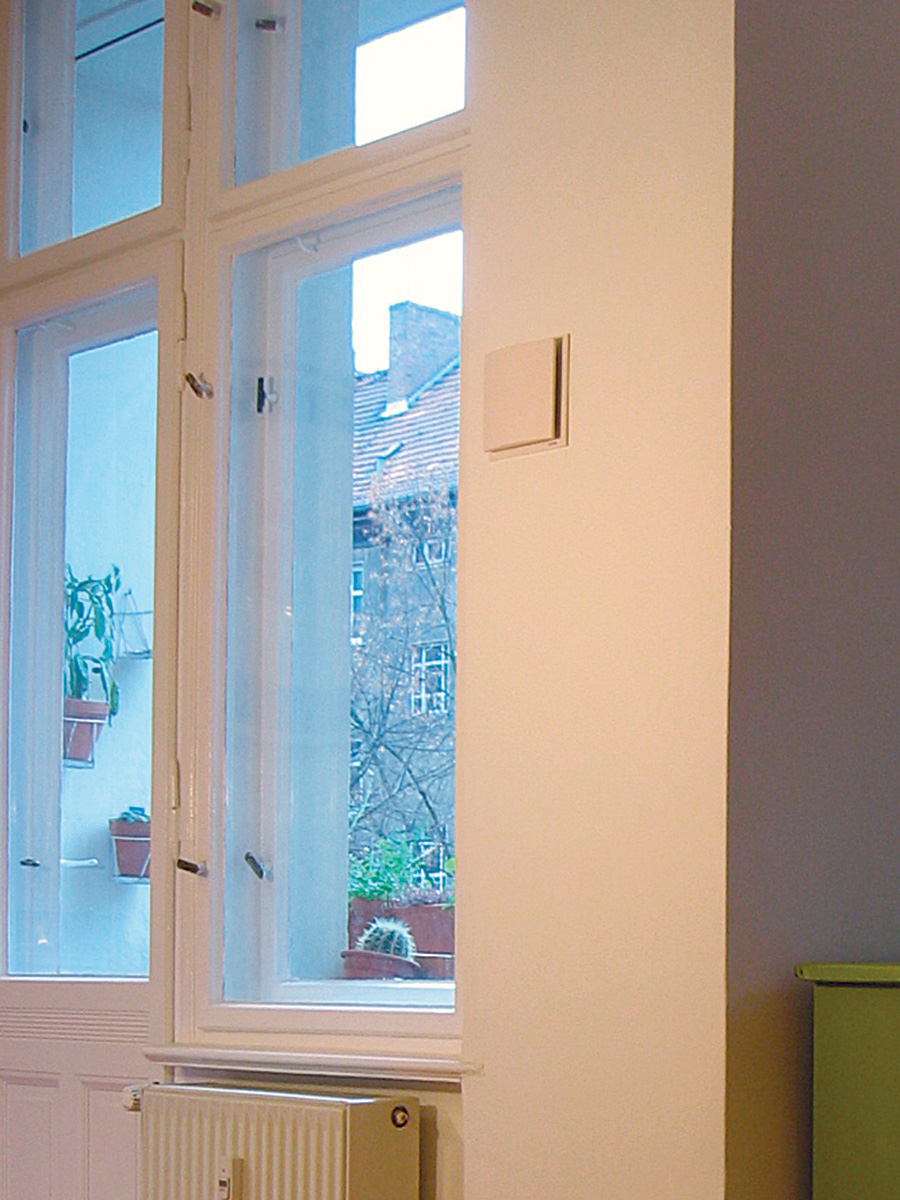
Comfort speaks to a unit’s thermal efficiency. Thermal efficiency is the recovery ventilator’s ability to transfer the temperature of the outgoing air to the incoming air. When a unit transfers a high percentage of the heat or cold to the incoming air, the fresh air can be diffused directly into the living space without creating cold drafts in the winter and warm eddies of air in the summer.
To compare the effects of efficiency on indoor-air temperature, let’s say the indoor temperature is 70°F and the outdoor temperature is 30°F. The makeup air an HRV that’s 75% efficient distributes through the house is 60°F—a far cry from the 30°F air pulled in by an air exchanger, but cool enough to be uncomfortable in a 70°F environment. A 90%-efficient HRV will raise the temperature of the makeup air to a more comfortable 66°F.
The Home Ventilation Institute (HVI), an independent agency, tests and reports the performance of HRVs and ERVs. You can compare the thermal efficiency of different units on its website, including both sensible recovery efficiency and apparent sensible effectiveness. It’s worth checking this database instead of relying on a manufacturer’s advertising.
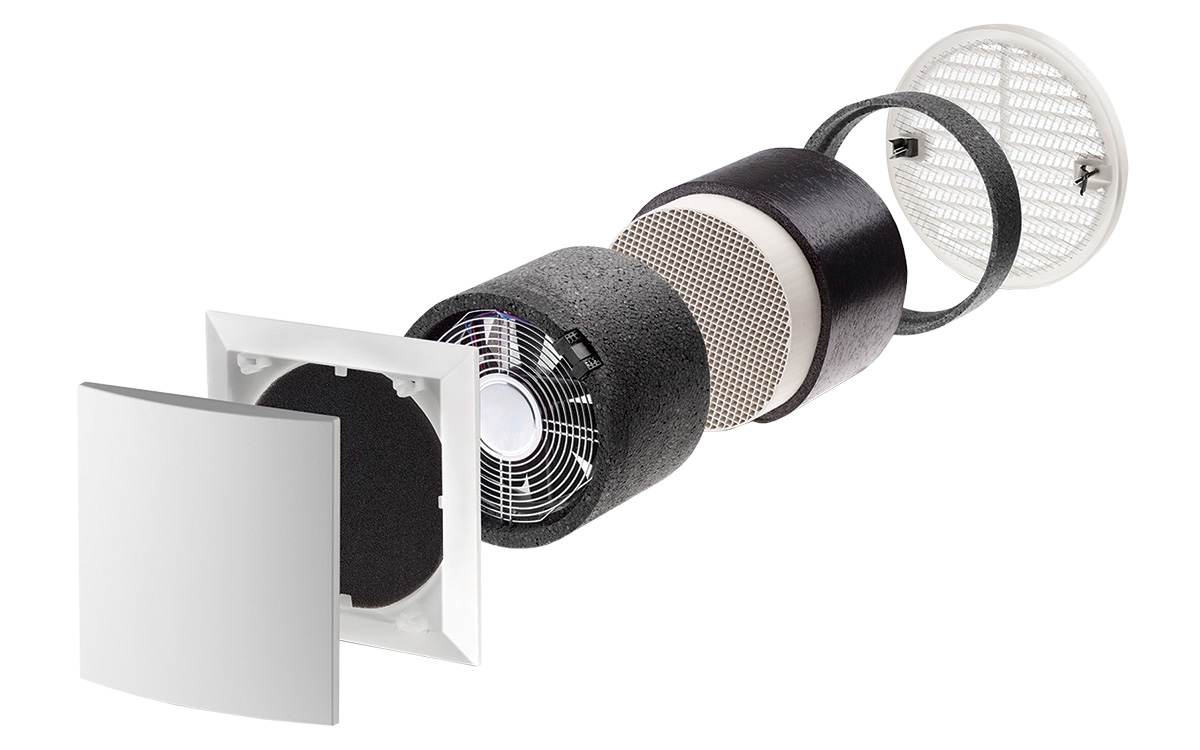
A Range of Ventilation OptionsBadExhaust-only ventilation uses a relatively low-volume bathroom fan run either continuously or at intervals on a timer to expel stale air from the home. Although excellent for their intended use, bath fans aren’t ideal as a whole-house ventilation solution. Drawing air through the fan creates a slight negative pressure in the house and pulls outside air through leaks in the envelope. There is no control over the source of incoming air. It could as easily come from the garage, basement, or utility room as around the jambs of a second-floor window. BetterSupply-only ventilation is the inverse of the exhaust scenario: A fan pulls fresh air into the house; under pressure, air finds its way out of the house through cracks. This is an improvement over the exhaust-only system because pressurizing the house makes the fan less likely to pull air from the garage and because incoming air can be filtered. Depending on the system, though, it can be inefficient to use the furnace fan to distribute air. BestBalanced ventilation makes the most sense if you intend to control the source of your fresh air. By relying on separate intake and exhaust fans working as a system, the amount of air that you expel from the house is matched by the amount of fresh air supplied by the ventilation equipment. This avoids depressurizing or pressurizing the house; the source of incoming air is planned and controlled, and it’s filtered. The fans are small and cheap to operate. Best of all, balanced systems are available with heat exchangers to recover the heating or cooling energy in the outgoing air. |
Is it cheap to operate?

A recovery ventilator should be airtight and well insulated, and it should have an ultra-efficient motor. The degree to which it diverges from this ideal determines overall efficiency and operating cost.
Recovery ventilators run continuously, so motor efficiency is critical. The most efficient machines use electronically commutated motors (ECMs). The best measure of overall efficiency is expressed as cfm/w, or how many watts it takes to exchange a cubic foot of air per minute. Plenty of recovery ventilators have a cfm/w ratio under 1.0, but aim for a value of 1.5 or better.
Is it excessively noisy?
A well-insulated house reduces sound transmission from the outside; as a side effect, noises from mechanical systems inside the house become much more noticeable. It’s important to install the recovery ventilator in a utility room away from the bedrooms.
Unfortunately, no independent organization tests these ventilation products for operating noise. The two recovery-ventilator brands I know that publicize noise levels are Lunos and Zehnder. Ratings are in decibels and not sones, which is the measure used for bath fans. Zehnder is the only system I’m aware of that incorporates a duct silencer.
In talking with architects and building scientists who have specified equipment for projects, I’ve heard a few brands consistently mentioned as quiet: Fantech, Venmar, and Zehnder. One feature consumers can look for are ECMs; in addition to being efficient, they are quieter than alternating-current (AC) motors.
Balanced ventilation should be recovery ventilation
There are three types of balanced mechanical ventilation. Each relies on one or more fans to bring fresh air into the house and to exhaust stale air out of the house. These are called balanced systems because the volume of air moved in each direction should be the same. Because differences in duct lengths and the number of elbows affect airflow, these systems need to be tested and tuned to achieve balance. This process, called commissioning, should be part of any installation.
Air exchanger
By pulling outdoor air into the house at the same rate it expels indoor air, an air exchanger provides balanced ventilation at a relatively low rate, say 60 cfm. Your fresh air won’t be quite as fresh as with a recovery ventilator, your stale air won’t be completely removed, and the mixing of airstreams is an inefficient way of conditioning supply air. The appliance itself, however, is far less expensive than an HRV or ERV.
HRV
A heat-recovery ventilator is perfectly suited for a heating climate. The idea behind it is simple: Outgoing stale air and incoming fresh air pass through a heat exchanger so that the warm air gives up its heat to the cool airstream. In winter, the outgoing warm air heats the incoming cold air; in summer, the incoming warm air gives up its heat to the outgoing cold air. The two airstreams are kept separate to prevent contaminants in the outgoing air from tainting the incoming fresh air. Efficiency is a function of how long the air spends in the heat exchanger. There are two heat-exchanger designs: crossflow and counterflow. The greater surface area of counterflow designs makes them more efficient, and there are three design types within this category: vertical flat panel, horizontal flat panel, and cellular. Vertical-flat-panel models are the least efficient (50% to 70%), followed by horizontal-flat-panel models (70% to 80%) and cellular heat exchangers (more than 80%).
ERV
An ERV is ideally suited for a cooling climate. Although it’s commonly referred to as an energy-recovery ventilator, ERV actually stands for enthalpy-recovery ventilator. Put simply, an ERV is a moisture- and heat-recovery ventilator. The only difference between an HRV and ERV is a vapor-permeable membrane between the exhaust and intake sides of the heat-exchange chamber. Instead of the aluminum or polypropylene that you’d find in an HRV, the material between the outgoing and incoming chambers in an ERV is a fabric akin to Gore-Tex. Vapor can pass through the material, but air, gases, odors, and bulk water cannot. Because ERV cores don’t have as much surface area as HRVs, they are not as efficient at heat removal. The typical efficiency penalty is about 10%.
Do you want an ERV or HRV?
One thing that often confounds people looking at recovery ventilators for the first time is whether they should choose an HRV or an ERV. The essential difference between the two is that an ERV transfers moisture, as well as heat, between the two airstreams. If you live in a region with a very consistent climate, then the answer is simple: Choose an HRV for cold climates and an ERV for hot, humid climates.
The problem is that a lot of North America falls into the mixed-climate category. To choose between an ERV and HRV in a mixed climate, you’ve got to look at the length of the cooling season, the amount of outdoor humidity, and the conditions inside the house.
First, consider that the flow of moisture in an ERV is from the warm, moist airstream to the cold, dry airstream. This means that in the summer, humidity is transferred to the colder stream, which is exhausting outside the house. In the winter, though, the colder stream is incoming, so the ERV is raising humidity levels in the house. That’s why home size and the number of occupants can make an ERV the wrong choice in some situations.
In a small, sufficiently air-sealed house with many occupants, the relative humidity in winter may be fairly high, and capturing and returning humidity to the house with an ERV could raise relative humidity to unhealthy levels. On the other hand, a larger house with few occupants could be made more comfortable by returning the relatively low moisture content to the house with an ERV. In these cases, an ERV might raise relative humidity 8% to 10% above the 35% to 45% relative humidity you’d get with an HRV.
In regions where the cooling season is dominant and there’s outdoor humidity, an ERV is the clear choice. When an ERV reduces the humidity of the incoming air, it’s making you more comfortable; it’s also easing the burden on your air-conditioning system by reducing the amount of moisture it has to remove from the air.
In colder regions, an HRV makes the most sense. There might be a slight comfort bump from an ERV’s raising of the relative humidity in winter, but it would be outweighed by the greater thermal efficiency of an HRV.
One machine but two efficiency scores
Recovery ventilators report thermal efficiency in two categories: sensible recovery efficiency (SRE) and apparent sensible effectiveness (ASE). SRE is the true measure of the heat exchanger’s efficiency; it measures only the amount of heat transferred across the plates of the heat exchanger, not including any outside variables. ASE includes heat from sources other than the exchanger itself. Waste heat generated from the unit’s motors, air leakage between the exhaust- and fresh-air streams, and heat from other appliances in the room can skew the apparent efficiency of the ventilator by more than 10%.
Forget HVAC. You want HAC & VTo get the most out of a ventilation system, decouple it from the heating and cooling systems. The potential problem with connecting your recovery ventilator to a forced-air heating and cooling system is that the furnace becomes the distribution fan for ventilation. A furnace fan is larger and less efficient than a recovery ventilator. Without a FanCycler or similar device, this overventilates the home and does so at a higher price. The other problem with using HVAC ducts for ventilation is that it short-circuits the air-exchange process. Properly installed ventilation creates airflow through the house by establishing a cascade of air from supply vents to exhaust vents (drawing left). Supply diffusers are placed in bedrooms or walk-in closets, while exhaust vents are placed in the bathrooms and the kitchen. The idea is that fresh air is delivered to the sleeping areas, drawn through the hallways into the common living spaces, and then vented out of the house from the bathrooms and the kitchen. This cascade design flushes stale air out of the house at relatively low cfm, reducing both energy use and noise. Adding air-supply diffusers in general living areas or having vents and supplies in the same room will short-circuit air movement, causing fresh air to flow directly from supply to exhaust. Bath vents should have boost switches, which increase the fan rate when moisture accumulates, either by humidistat control or a manually activated timer switch. In the kitchen, a recovery ventilator intake cannot take the place of a range hood. Separate ventilation is needed for airborne oils. To keep ventilation rates balanced, system designers often recommend an induction cooktop because there’s no combustion. A recirculating hood can then be used to trap oil and to push air back into the kitchen so the ERV or HRV can exhaust it. |
Sean Groom is a contributing editor. Photos courtesy of the manufacturers.
Drawings: Christopher Mills

